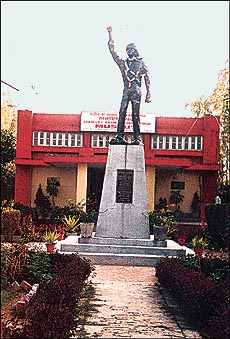Keeping
alive the memories of martyrs
By Rameshwar
Mehta
THE stretch of highway between
Nawanshahr and Banga is dedicated to the memory of
Shaheed Bhagat Singh and is named Shaheed-e-Azam
Sardar Bhagat Singh Marg. Decorative sign boards on the
either side of the road are on display. On this road at a
distance of 100 km from Chandigarh lies Khatkar Kalan, a
village which has the proud privilege of being the
birthplace of a family of revolutionaries who laid down
their lives so that their countrymen may live in the
‘glow’ of freedom. Bhagat Singh was born in
this family and became a household word countrywide. He
ignited the revolutionary spirit among his countrymen to
cause the downfall of British Imperialism in India,
kissed the gallows together with Rajguru and Sukhdev on
the March 23, 1931, in Lahore Jail.
 As a commemorative tribute to this great son
of Punjab and his compatriots who had raised the banner
of revolt against British Raj, the Government of Punjab
erected a museum at Khatkar Kalan on March 23, 1981,
being the 50th martyrdom anniversary of Bhagat Singh. As a commemorative tribute to this great son
of Punjab and his compatriots who had raised the banner
of revolt against British Raj, the Government of Punjab
erected a museum at Khatkar Kalan on March 23, 1981,
being the 50th martyrdom anniversary of Bhagat Singh.
Outside the museum
building in the front court-yard,there is a life size
statue of Bhagat Singh with raised arm and clenched fists
in a slogan shouting posture as if saying: Down with
imperialism inqulab zindabad, I felt electrified.
Bowed to the statue and marched to the gate of the Museum
where my eyes met with the lines: Shaheedon ki chitaon
par lagenge har baras mele: Vatan pe mitney walon ka yehe
baaki nishan hoga.
I entered the Museum and
came to the brass statues of Bhagat Singh,Rajguru and
Sukhdev placed in a trimurti style with the inscription
on the pedestal base, Ho farishtey bhi fida jin par
yeh woh insaan hein.
I was struck with
reverence, turned towards the portrait gallery displaying
the martyrs’ family photographs. Right from his
grandfather and grandmother to his father Kishan Singh
and uncle Ajit Singh who served in jails at Lahore and
Mandlay for the cause of motherland. It is said that the
grandmother of Bhagat Singh used to call him Bhaganwala
because the news of release of his father and uncle
from jail had coincided with Bhagat’s birth. The
photographs of his mother and sisters also find proud
place in the gallery. Besides, the portrait gallery has a
number of photographs of his compatriots, revolutionaries
and ghadarites who inspired Bhagat Singh to wage the
struggle. I was the engrossed in thoughts of the times I
was not a witness to. Curator’s warning to
"hurry up" jolted me when I was reading on the
portrait board Ab to kha baithen hein, Chittagarh ki
kasmein: sarfaroshi ki ada deti hein rasmein. I
hissed and surged forward to the glassed vaults section
of the Museum.
This section preserved the
mementoes and relevant material relating to the great
martyrs and revolutionaries. I came face to face with the
first page of the diary of Bhagat Singh with the notes
which read ‘Lover, Lunatic and Patriot’ are
made of the same stuff. He had drunk the nectar of love
for his country. He also wrote ‘My strength is the
strength of the oppressed, my courage is the courage of
desperation’.
The next vault exhibited
the blood soaked pebbles, sands and half-burnt bones of
the martyr brought by martyr’s sister Bibi Ajmer
Kaur from the bank of Sutlej where he was hanged and
burnt. I was sad and remorseful. Then my eyes caught the
inscription on the plate Shaheed ka jo khoon hai, Kaum
ke inyat.
In the same vault lies the
nasty pen with which the death sentence was awarded to
martyrs. Other notable exhibits include Sukhdev’s
Kulah, copy of judgement of the First Lahore Conspiracy
Case, copy of the Bhagvadagita with the autograph
of the martyr. These exhibits are silent reminders of
supreme sacrifice the martyrs made for the motherland.
|

![]()

